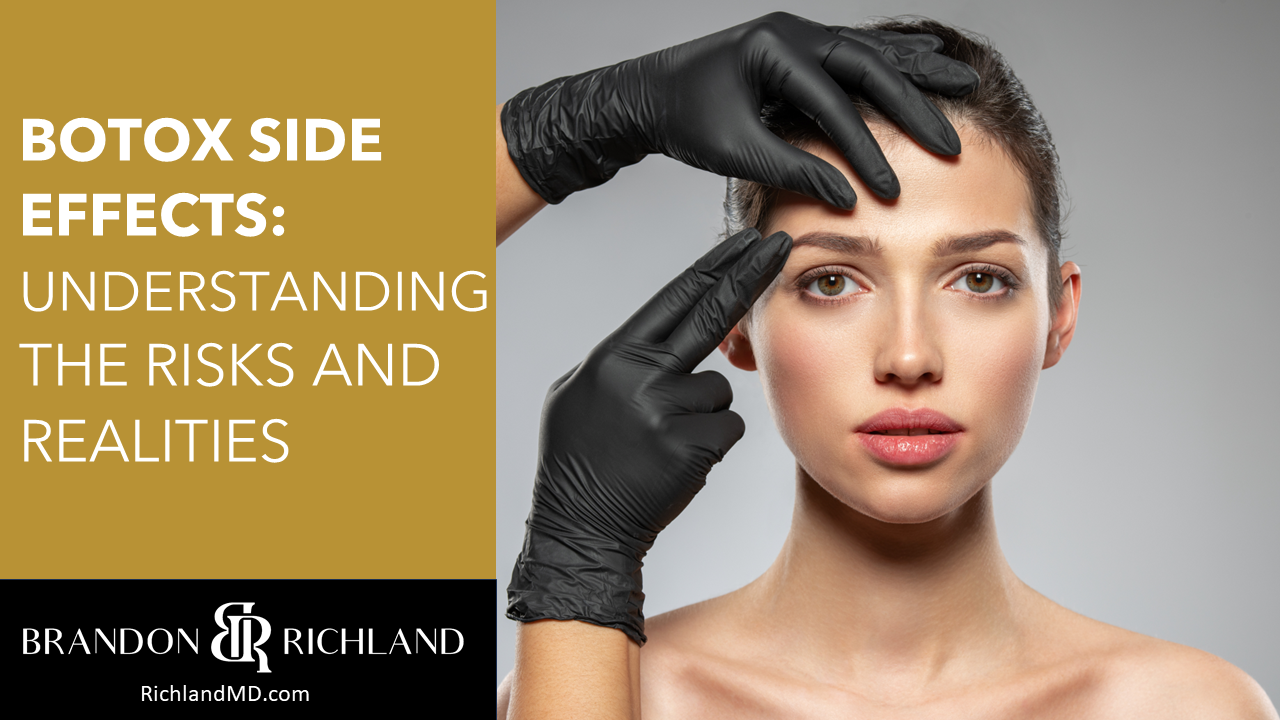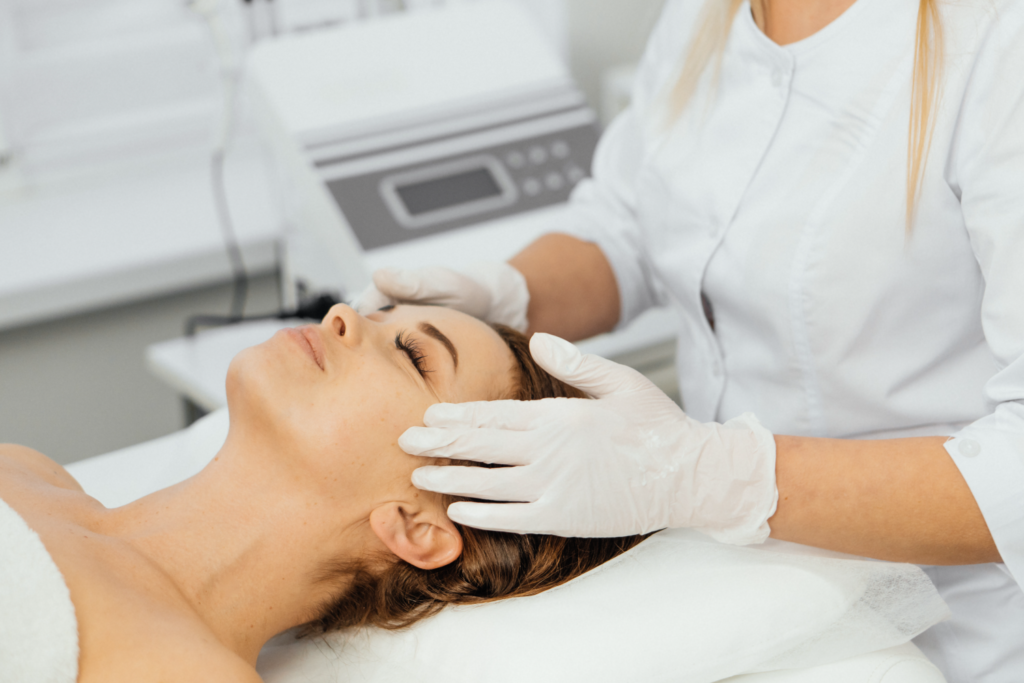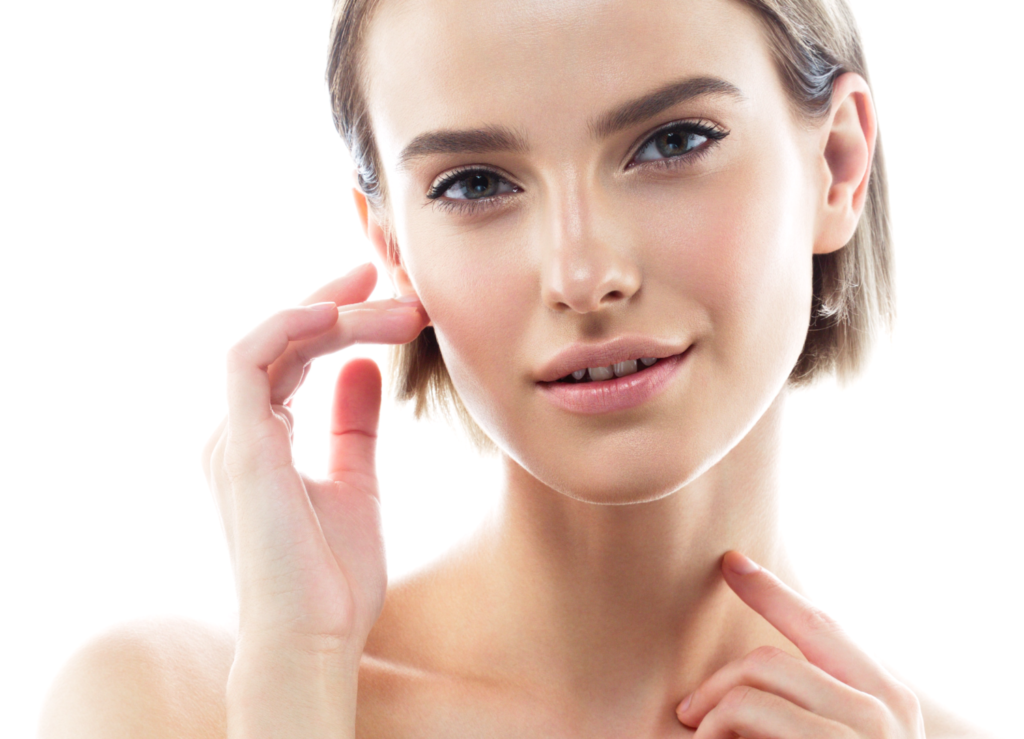Published by Dr. Brandon Richland, MD

Botox, a branded form of botulinum toxin injection, has gained widespread popularity for its cosmetic and medical applications, most notably in the reduction of facial wrinkles. While its aesthetic benefits are well-known, it’s important to be aware of the potential side effects associated with its use.
The side effects can range from mild, temporary issues to more serious complications, depending on various factors, such as the individual’s response to the toxin, the area treated, and the dosage administered.
It is crucial for individuals considering botulinum toxin type to understand that, while many experience no adverse reactions, others may encounter side effects like neck pain, headache, bruising, or muscle weakness near the injection site. Not all side effects are immediate; some may develop over time.
For those who are treated for medical conditions, such as chronic migraines or muscle spasms, the side effects can differ. Being informed about these potential outcomes, recognizing early signs of complications, and knowing when to seek professional advice are essential steps for anyone undergoing or contemplating Botox treatments.
Key Takeaways of Botox Side Effects
- Botox is used cosmetically to reduce wrinkles and medically to treat certain conditions.
- Side effects can range from minor, such as injection site reaction, to more significant health issues.
- Awareness and timely response to any adverse effects are key to managing Botox injections safely.
Understanding Botox and Its Uses
Botox, known for both its therapeutic and cosmetic benefits, is a versatile treatment derived from a neurotoxin produced by the bacterium Clostridium botulinum. It’s important to recognize the distinct applications of Botox in medical contexts as well as its widely acknowledged role in aesthetic enhancement.

Medical Applications
The therapeutic use of Botox is significant in managing various medical conditions. One of its key roles is in the treatment of chronic migraine, where it helps to reduce the frequency of headaches. Botox is an effective treatment for overactive bladder (OAB), alleviating symptoms like incontinence and urgency.
Another critical application is in addressing abnormal muscle contractions. These might manifest as neck spasms (cervical dystonia), crossed eyes (strabismus), or even a condition called blepharospasm, which is characterized by involuntary eyelid closure.
Cosmetic Purposes
In the realm of aesthetics, Botox’s primary function is to diminish the appearance of wrinkles. It works by temporarily relaxing the facial muscles responsible for expression lines, such as crow’s feet or frown lines. The popularity of Botox for cosmetic purposes underscores its reputation as a minimally invasive solution for age-related skin concerns.
Common Side Effects of Botox
Botox treatments are widely used for both cosmetic and medical purposes. While generally considered safe, they do come with a range of side effects that recipients should be aware of.
Mild Reactions
Mild side effects from Botox are typically short-lived and should resolve on their own. They may include symptoms such as headaches, which can occur shortly after the treatment. Some people also experience flu-like symptoms that usually dissipate within a few days after the injection.
Injection Site Concerns
The area of Botox injection can display several reactions, commonly referred to as injection site reactions. Common side effects at the injection site are:
- Pain or discomfort during and shortly after the procedure
- Bruising, which can vary in severity and usually fades over a few days
- Swelling that typically subsides quickly
- Minor bleeding, often a result of the needle entering the skin
Localized side effects at the injection site, such as redness or tenderness, may appear soon after the treatment but are expected to diminish over the following days.
Risks for Specific Populations
While Botox is widely used for cosmetic and medical purposes, certain groups such as children and pregnant or breastfeeding women need careful consideration.
Effects on Children
Botox is not approved for cosmetic use in children and its use is generally limited to specific medical conditions. For pediatric patients, there are concerns about its effect on growing muscles and nerve development.
Pregnancy and Breastfeeding Cautions
Pregnant women are typically advised to avoid Botox. Similarly, those who are breastfeeding should be cautious, as it’s not established how Botox may impact the breast milk and the nursing infant.
Allergic Reactions and Overdose
When considering Botox treatments, it’s important to be aware of the potential for allergic reactions and the symptoms of overdose. Allergic reactions can vary but may include itching or rash, while overdose symptoms could be indicative of botulism, a serious condition.
Identifying Allergic Responses
Patients receiving Botox may experience an allergic reaction. Signs of such a reaction include:
- Itching: Persistent itching around the injection site or elsewhere on the body.
- Rash: The appearance of hives or a rash which may spread beyond the site of injection.
Allergic reactions warrant immediate attention from a healthcare provider.
Understanding Overdose Symptoms
Botox overdose is rare but can lead to symptoms suggestive of botulism, such as:
- Muscle Weakness: A sudden onset of muscle weakness in parts of the body.
- Difficulty Swallowing or Speaking: Challenges with speaking or swallowing; these may signal a medical emergency.
Overdose symptoms require urgent medical evaluation.
Injection Process and Aftercare
Ensuring a smooth Botox experience involves understanding the procedure itself and how to care for one’s skin post-injection. This knowledge helps minimize side effects and maximizes the treatment’s benefits.
Before the Injection
Before receiving a Botox injection, it’s crucial for patients to consult with their healthcare provider to cover all pre-procedure instructions. Clinics may advise avoiding blood-thinning medications or supplements to reduce the risk of bruising.
Patients should also inform their specialists about any medications, allergies, or medical conditions to ensure Botox is safe for them.
Post-Injection Care
After the injection, patients should follow specific aftercare instructions to aid in recovery and effectiveness. Patients should also be cautious not to massage or rub the botox injection site to prevent the toxin from spreading to unintended areas.
Activities such as gentle facial exercise can be beneficial, but it is wise to avoid strenuous exercise that could elevate heart rate excessively on the day of treatment. Patients should also refrain from touching or applying pressure to the treated areas to prevent the spread of Botox to unintended muscles.

Drug Interactions and Contraindications
When considering Botox treatments, it’s crucial to be aware of possible drug interactions and contraindications. The medications a patient is currently taking, including over-the-counter drugs, supplements, and alcohol, can affect the safety and efficacy of Botox.
Contraindicated Medications
Medications that should not be used with Botox:
Certain medications are contraindicated with Botox due to the increased risk of serious side effects. These include:
- Aminoglycoside antibiotics (e.g., gentamicin), which may amplify the effect of Botox.
- Blood thinners (e.g., warfarin), which can increase the risk of bleeding and bruising.
- Muscle relaxants, which may enhance the neuromuscular effects of Botox.
Patients should always inform their healthcare provider of all the medications they are taking before starting Botox treatment.
Potential Interaction Risks
The risk for interactions does not end with prescription medications. Over-the-counter products, certain supplements, and other substances can also affect how Botox works:
Interactions with alcohol:
Alcohol consumption might increase the likelihood of bruising and should be avoided in the days leading up to and following Botox injections.
Combination with certain medications:
While not strictly contraindicated, some medications may alter the intended effects of Botox. These include:
- Nonsteroidal anti-inflammatory drugs (NSAIDs), which may increase bruising risk.
- Anticholinergic drugs, which might potentiate the effect of Botox.
Thorough communication with healthcare providers regarding all ingested substances is vital for minimizing risks.
Regulatory and Safety Information
When considering Botox treatment, it’s important to acknowledge the regulatory framework and safety data that guide its usage.
The FDA strictly evaluates and approves Botox for specific indications, ensuring that licensed healthcare providers administer the treatment in a safe manner, with adherence to the protocol and an understanding of potential warnings.
FDA Approval
Botox, a purified botulinum toxin, is FDA approved for both cosmetic and therapeutic uses. The FDA’s approval process involves rigorous assessment of safety and efficacy, through which Botox has been sanctioned for various conditions.
For example, the treatment’s cosmetic approval was granted for the temporary improvement in the appearance of moderate to severe forehead lines, crow’s feet, and frown lines in adults.
Clinical Studies and Research
Extensive clinical studies and research underpin the FDA’s approval of Botox. Studies have documented the profile of side effects associated with the toxin, ranging from mild, like bruising at the injection site, to more severe conditions, such as an allergic reaction.
Healthcare professionals are well-informed about these potential side effects and the importance of monitoring patients after treatment.
Alternatives to Botox
Seeking alternatives to Botox? One may consider both injectable and non-injection treatments that offer benefits such as reducing the appearance of wrinkles and providing a more youthful complexion, without the use of Botox.
Other Injectable Treatments
- Dysport: Similar to Botox, Dysport uses botulinum toxins to reduce wrinkles, but with some subtle differences in formulation and diffusion.
- Xeomin: Another botulinum toxin product, Xeomin prides itself on containing just one ingredient, and is often recommended for those who may have developed resistance to other neurotoxins.
Non-Injection Options
- FaceXercise: This technique involves exercises aimed at toning the facial muscles, much like physical exercise does for the body.
- Topical Creams: There are creams that promise to mimic the effects of Botox with ingredients such as peptides that may help in reducing the appearance of lines.
These alternatives offer various options to attain similar results as Botox, each with its own set of characteristics and potential benefits.
Frequently Asked Questions About Botox Side Effects
1. What Negative Effects Might Someone Experience After Botox Treatment?
Following a Botox injection, individuals may encounter side effects such as pain, swelling, or bruising at the injection site. There can also be flu-like symptoms, headache, or facial droop.
2. Are There Any Long-Term Consequences Associated with Botox Injections?
Typically, Botox is regarded as safe, and long-term side effects are uncommon. However, continued use may lead to diminished muscle strength in the treated areas over time.
3. How Soon After Treatment Do Botox-Related Side Effects Typically Subside?
Most side effects from Botox injections are usually temporary, resolving within days to a couple of weeks after treatment.
4. Could Botox Injections Potentially Affect The Eyes?
Botox injections near the eye area can lead to side effects such as drooping eyelids, dry eyes, or tearing. Patients experiencing any changes in vision should consult their healthcare provider.
5. Are Certain Individuals Advised Against Undergoing Botox Procedures?
People who are pregnant, breastfeeding, or have certain neurological diseases should avoid Botox. Anyone with allergies to any components of Botox is also advised against having the treatment.
6. After Receiving Botox, How Long Do Patients Normally Observe Side Effects?
The duration of side effects from Botox can vary, but they typically last for a few days to a couple of weeks post-procedure. Some individuals may experience symptoms for a shorter or longer time.

Conclusion and Summary of Botox Side Effects: Understanding the Risks and Realities
Botulinum toxin injections, commonly known as Botox, are utilized for both therapeutic and cosmetic purposes. In therapeutic and cosmetic cases, Botox is administered through various methods, including intradermal injection, which is often used for reducing wrinkles on the forehead.
While many individuals benefit from their effects in treating issues ranging from migraine symptoms to excessive sweating, the treatment is not without potential side effects.
The Food and Drug Administration (FDA) has issued warnings about serious adverse effects that may include the drug’s toxin effects spreading beyond the treatment area. In therapeutic and cosmetic cases, Botox is administered through various methods, including intradermal and intramuscular injections, directly into the affected muscles.
Individuals considering Botox must consult healthcare professionals about the risk, align treatments with their health conditions, and consider the most serious warnings issued by the drug administration FDA.
Please note that this article is intended for informational purposes only and should not be construed as medical advice. Before making any changes to your treatments, please consult with your healthcare provider to discuss the appropriateness and safety of such changes.
Ready For Your First-Class Cosmetic Experience in Orange County (OC) California (CA)?
Are you located in one of these Orange County (OC) / Southern California cities?
Aliso Viejo, Anaheim, Brea, Buena Park, Costa Mesa, Coto de Caza, Cypress, Dana Point, Fountain Valley, Fullerton, Garden Grove, Huntington Beach, Irvine, La Habra, La Palma, Laguna Beach, Laguna Hills, Laguna Niguel, Laguna Woods, Ladera Ranch, Lake Forest, Los Alamitos, Mission Viejo, Newport Beach, Orange, Placentia, Rancho Santa Margarita, San Clemente, San Juan Capistrano, Santa Ana, Seal Beach, Stanton, Tustin, Villa Park, Westminster, or Yorba Linda?
Plastic Surgeon Dr. Brandon Richland, MD and our Cosmetic Aesthetics Team are ready to help you look and feel your absolute best.
Elevate your confidence and self esteem levels to unfathomable new heights!
Schedule your in-person consultation in our modern and luxurious offices in either Fountain Valley, CA (Main HQ) or our Newport Beach, CA office.
Do you live outside of Southern California or short on time? For your convenience, Virtual Consultations are also available.
Our warm and engaging Team of carefully selected Aesthetics Professionals will make you feel calm, cool, collected, and right at home throughout your entire consultation and surgery process.
Schedule Your Aesthetics Consultation here, or call us directly at 949-867-4496 today.
About the Author

Dr. Brandon Richland, MD is a respected Board Certified Licensed Plastic Surgeon in Orange County / Southern California specializing in cosmetic and reconstructive surgeries.
Driven by his passion for medicine, Dr. Richland obtained his Doctor of Medicine (M.D.) degree from the prestigious program at Saint Louis University (SLU) School of Medicine in 2013. His exceptional skills were recognized when he received the McGraw Hill / Lange Medical Student Academic Achievement Award, and graduated top of his class with Honors. For his undergraduate degree, he attended University of California, Los Angeles (UCLA) and graduated with Honors in 2009.
To further enhance his surgical expertise, Dr. Richland completed his Residency in Plastic Surgery at the University of California, Irvine (UCI) from 2013 to 2019 earning the Academic Achievement Award twice during this period. A total of 14 years in dedicated schooling and medical residency.
Dr. Richland is actively involved with healthcare and medical societies, as a Diplomate of the American Board of Plastic Surgery, a member of the American Society of Plastic Surgeons, American Society of Aesthetic Plastic Surgeons, and the California Society of Plastic Surgeons.
Contact Dr. Richland today by visiting RichlandMD.com, scheduling a cosmetic consultation, or by calling 949-867-4496 directly.










